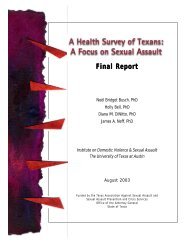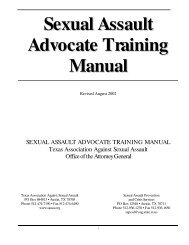Sexual aSSault LEGAL ADVOCACY MANUAL - Texas Association ...
Sexual aSSault LEGAL ADVOCACY MANUAL - Texas Association ...
Sexual aSSault LEGAL ADVOCACY MANUAL - Texas Association ...
Create successful ePaper yourself
Turn your PDF publications into a flip-book with our unique Google optimized e-Paper software.
Mens reA Identity of Victim Harm to Victim<br />
By Act<br />
(1) Intentional,<br />
(2) Knowing,<br />
(3) Reckless,<br />
or<br />
(4) Criminally negligent<br />
(1) Child,<br />
(2) Elderly person,<br />
or<br />
(3) Person with a<br />
disability<br />
(1) Serious bodily injury,<br />
(2) Serious mental<br />
injury/impairment,<br />
or<br />
(3) Bodily injury<br />
By Omission<br />
(1) Intentional,<br />
(2) Knowing,<br />
or<br />
(3) Reckless<br />
(1) Child,<br />
(2) Elderly person,<br />
or<br />
(3) Person with a<br />
disability<br />
(1) Serious bodily injury,<br />
(2) Serious mental<br />
injury/impairment,<br />
or<br />
(3) Bodily injury<br />
Thus, if a person’s conduct causes one of those results to a type of victim listed in the statute, and the<br />
person acted with the state of mind required by the statute, then the person has committed this crime.<br />
Analyzing crimes in this way might seem overly complicated, but that is what prosecutors and police<br />
officers do with every criminal complaint they receive. When we talk about proving a crime beyond a<br />
reasonable doubt, what we really mean is proving each and every element of both the mens rea and actus<br />
reus components beyond a reasonable doubt. That is what is required to convict any criminal defendant.<br />
Therefore, it is important for legal advocates to have a basic understanding of how substantive criminal<br />
law works. When you can break down a criminal statute to its basic parts in this way, you can better<br />
communicate with the players in the justice system, which means you can also be more helpful to<br />
survivors. For example, understanding how the criminal statutes work enables you to discuss and<br />
understand why a prosecutor feels a lesser offense is easier to prove than sexual assault, or why the<br />
prosecutor wants to offer a plea agreement instead of going to trial (p. 55, Plea Bargains). You will also be<br />
more helpful to the survivor during the investigation, because you will better understand what evidence<br />
police need and why.<br />
11
















